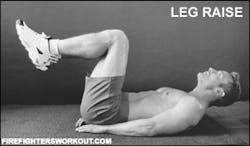In this series of articles, we take a close look at various firefighting activities, and show how to encourage optimal performance and unprecedented protection of your bones and soft tissues under emergency conditions. By taking this systematic approach, you can boost both safety and your job performance on the fire-ground.
Ladder company operations, or simply "truck work" combines a variety of strengths and skills, but even with all the advanced technology in the fire service today, ladder company hand tools continue to be the staple of every truckee.
No piece of equipment gets more use during overhaul operations than the age-old six-foot hook. Becoming proficient in the use of the ceiling hook can sometimes require an element of raw power. How we're able to develop the force necessary to get the job done will determine the overall level of force you're able to generate, as well as its impact on your body.
Your dynamic posture (the position of your body as it goes through motion), from the recoil phase (pulling back before thrusting) to the actual thrust or strike phase is something that can be trained and prepared for. Let's take a closer look.
Movement Analysis and Body Positioning: The Ceiling Pull
Ladder operations at any advanced fire, especially in a non-fireproof structure, invariably involves the removal of extensive ceiling section. Older building with everything from wire-mesh lath and plaster to tin ceilings represent a challenge to the truck company assigned to remove them. Most often the six-foot hook is the tool of choice.
The Initial Thrust
Be sure all your gear is fastened, and you have no swinging belts, or flashlights that can swing upon impact. Hold your shoulders relaxed and down even when weighted down with bunker gear and a SCBA. Keep your abdominal muscles firm, providing protection for your lower back and spine, also allowing for a more efficient transfer of power from the lower to upper body.
Assume a boxer stance and keep you feet planted firmly on the floor, far enough apart to provide optimal balance. Stand behind your target. Adjust your grip on the hook to allow for ceiling height, and if possible, hold low enough on the pole so as not to require excessive overhead arm extension.
With eyes on your target and a firm grip, execute a short, sharp thrust. Your body weight should shift from your back to front leg (boxer stance) as your extend your arms. If you can determine the run of the beams and lath, align the head of the hook to allow for the easiest penetration.
The Pull Back
Once the head of the hook penetrates the ceiling space, turn the tool to pull back as much material as possible on your reverse thrust or pull back. Without changing your grip, shoulders still relaxed and down, abs firm, use your body-weight and gravity to drop the hook back through the ceiling. Utilizing body weight, instead of just pure upper body strength, gives you both more endurance and power with each pull.
Continue to move at a steady pace that conserves energy. You might be called upon to perform extensive overhaul in a smoky, toxic environment that requires mask usage. Be sure to inform your officer when you experience heavy fatigue, as this is the time injuries are most likely to occur. Protect yourself!
CEILING PULL MOVEMENT CHECKLIST
- Stand slightly forward of your target, not directly under it
- Feet in boxer stance, with more weight initially an rearward leg
- Shoulders down and back
- Abdominal muscles pulled in and held tight
- Adjust grip up or down on hook dependent upon ceiling height
- Initial thrust should be short and sharp with body weight shift
- Stress use of body weight, not upper body strength for pull back
- Pace yourself and call for relief to avoid injury
Featured Exercise
Get more exercises at FireFightersWorkout.com
Leg Raise
Lie on your back with your knees bent and feet flat on the floor, hip-width apart. Contract your abdominal muscles as you flatten your lower back into the floor. Keep the low back pressed into the floor throughout the entire exercise by maintaining that abdominal contraction. This will feel like you're pulling your navel down. If during the exercise, you find you're low back lifting up, or hips rocking from side to side, it means your abdominal muscles are not capable of maintaining this position and you should either stop or revert back to a less intense version (see progression below). Keep your head flat on the floor, and arms at your sides throughout the exercise. You can place a folded mat or pillow under your head, neck and/or upper back for support if necessary.LEG RAISE PROGRESSION
- LEVEL ONE - From the position described above, extend one leg by SLIDING your foot along the floor (straighten knee) and return to starting position. Repeat with opposite leg.
When you can perform 20 repetitions, proceed to the next level. If you experience any hip, back or neck pain, discontinue.
The Leg Raise can build abdominal strength necessary to execute strenuous tasks safely and efficiently. Using this exercise as part of a full body approach to health and fitness will go along way to protecting your career, and making you an asset, not a liability to your department.
Related:
Related TrainingLIVE Webcast:
- Health & Fitness: Task Specific Training Watch It Now!





